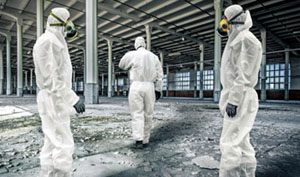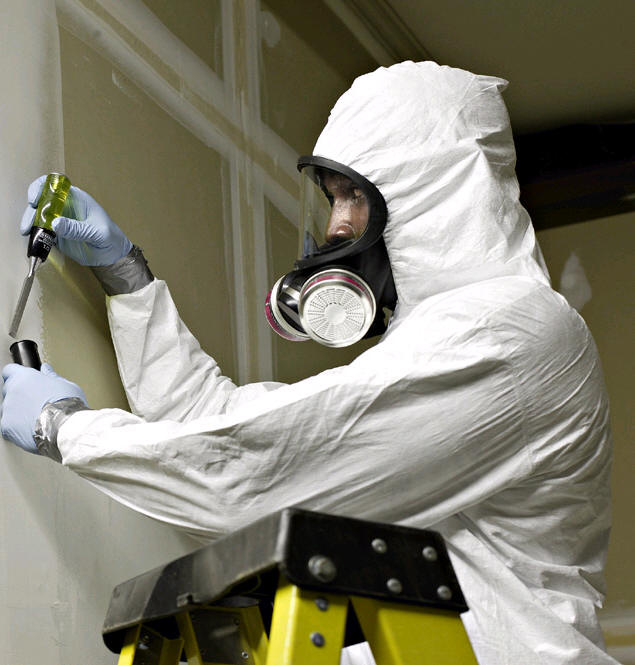Arrange Your Asbestos Testing Today for a Healthier Home
Arrange Your Asbestos Testing Today for a Healthier Home
Blog Article
The Total Process of Accredited Asbestos Evaluating to Guarantee Home Conformity
In the world of building monitoring and conformity, the procedure of recognized asbestos screening stands as a crucial element to make sure the safety and security and well-being of occupants. Recognizing the detailed actions entailed in this screening method is critical for property owners and managers alike. From the preliminary evaluation to the final interpretation of results, each stage plays a vital duty in establishing the existence of asbestos within a property. Allow's explore just how this meticulous process unfolds to guarantee adherence to stringent regulations and secure versus possible carcinogen.
Accredited Asbestos Screening: Preliminary Assessment
In performing the initial evaluation for approved asbestos screening, a meticulous evaluation of the home's products is vital to accurately determine prospective asbestos-containing products. Special focus is given to materials that are prone to harm or disturbance, as these scenarios can launch damaging asbestos fibers right into the air.
Approved asbestos assessors adhere to rigorous methods established by regulative bodies to make sure the precision and integrity of the screening procedure. By carefully documenting findings and utilizing sophisticated testing methods, assessors can offer home owners with an extensive report describing the existence of asbestos, if any, and the suggested steps for mitigation or elimination. This preliminary evaluation sets the structure for succeeding actions to address asbestos concerns and guarantee the security and compliance of the building.
Example Collection Procedures for Asbestos Examining
Efficient example collection procedures are essential in making certain precise asbestos testing outcomes and conformity with regulative criteria. When gathering examples for asbestos testing, it is critical to follow rigorous methods to decrease the danger of contamination and guarantee the reliability of the outcomes.
First of all, it is necessary to determine the believed asbestos-containing materials (ACMs) and prioritize tasting locations based on aspects such as the product's condition, ease of access, and possibility for disturbance. Asbestos Testing. Samples need to be collected from different areas within the residential or commercial property to supply a thorough analysis of asbestos presence
During example collection, certified professionals must put on appropriate personal protective devices (PPE) to secure versus asbestos direct exposure. They must utilize tidy tools, such as non reusable handwear covers and plastic sheeting, to avoid cross-contamination in between examples. Examples must be meticulously collected utilizing a defined method, such as wet wiping or coring, and firmly secured in closed containers to preserve their honesty throughout transportation to the laboratory for evaluation.
Research Laboratory Evaluation Process for Asbestos Samples
Upon conclusion of the sample collection procedure, the asbestos examples are carefully transferred to accredited research laboratories for careful analysis. The first action in the lab evaluation procedure is sample preparation, where the accumulated samples are meticulously refined to draw out the Get More Information asbestos fibers.

As soon as the evaluation is complete, an in-depth record is produced, describing the searchings for and confirming whether asbestos exists, the kind of asbestos fibers recognized, and the focus levels. This information is critical for homeowner to take the needed actions to guarantee compliance with asbestos policies and safeguard the health and wellness of passengers.

Reporting and Interpretation of Asbestos Examination Results
Recognized asbestos screening laboratories offer thorough records that offer important understandings into the visibility, type, and focus levels of asbestos fibers found in samples gathered from buildings. These reports are important for residential property owners and managers to recognize the threat posed by asbestos and make informed decisions regarding its management or removal. The records generally include information on the techniques utilized for testing, the locations where samples were taken, the type of asbestos identified (such as chrysotile, amosite, or crocidolite), and the focus levels of asbestos fibers identified.
Interpreting these results calls for expertise to assess the potential wellness threats connected with asbestos exposure, identify the suitable training course of activity, and guarantee regulatory conformity (Asbestos Testing). Depending upon the findings, suggestions may range from proceeded tracking and maintenance to encapsulation or complete asbestos reduction. Homeowner need to meticulously examine these reports and talk to asbestos specialists to establish an extensive prepare for resolving any type of asbestos issues recognized
Ensuring Building Conformity With Asbestos Laws
To maintain adherence with asbestos guidelines, residential or commercial property proprietors should faithfully execute actions to make certain compliance with applicable legislations and guidelines. This includes performing routine asbestos evaluations by recognized professionals to recognize any kind of visibility of asbestos-containing products within the building. Once asbestos is determined, residential or commercial property proprietors must follow asbestos administration prepares that synopsis proper containment, elimination, or encapsulation treatments to check out here stop exposure and spread of asbestos fibers. Conformity additionally involves keeping in-depth documents of asbestos testing, maintenance, and elimination tasks for inspection objectives.
Homeowner ought to offer asbestos awareness training to staff members and occupants to decrease the danger of asbestos direct exposure and guarantee appropriate handling of materials that may include asbestos. Furthermore, it is important to stay educated concerning any type of updates or adjustments in asbestos policies to readjust management methods as necessary. By proactively addressing asbestos compliance needs, homeowner can develop a safe setting for residents and reduce potential lawful and health threats connected with asbestos exposure.
Conclusion
In verdict, accredited asbestos check that screening is a crucial procedure for making sure residential property conformity with guidelines. The initial analysis, sample collection treatments, lab evaluation, and analysis of results are very important action in this procedure. By following these treatments, residential property owners can determine and address any asbestos threats present, safeguarding the health and wellness and security of residents and keeping compliance with regulative demands.
Report this page